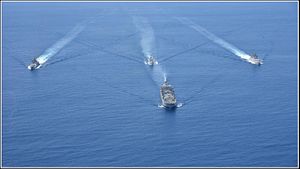In a recent article, Abhijit Singh explains how the Indian Navy has stepped up its humanitarian operations in the Indian Ocean since 2004. The purpose of this action is twofold; to simultaneously provide a foundational maritime maintenance function in the region, while also hedging against an increase in the range and power of the Chinese People’s Liberation Army Navy (PLAN). As Singh notes, humanitarian assistance/disaster relief (HADR) has become a core naval mission since 2004, one that all major powers need to take seriously.
A belief in the strategic significance of HADR has spread across multiple navies in the last decade or so. The United States Navy (USN) has made HADR cooperation a key element of its approach in Southeast Asia, as well as other regions; collaborative HADR training builds relationships and procedures that allow the USN to maximize its influence. The United States Navy has made HADR central to its claim of preeminence in management of the maritime commons. The navies of the European Union and the United Kingdom have adopted this same kind of rhetoric. Indeed, much consideration has been given to the prospect of increasing USN-PLAN cooperation in this field, potentially as a way of locking in a commitment from the Chinese to certain kinds of maritime support.
For its part, the PLAN has invested heavily in platforms that can perform the HADR mission, including hospital ships and amphibious warfare vessels. The USN, of course, has a huge lead in such dual purpose vessels, but also thinks of itself as having global responsibilities. As Singh notes, the Indian Navy lags behind the other two navies in large platforms that can capably perform the HADR mission.
The Indian Navy’s recognition of the strategic implications of HADR is also interesting in context of how China and India are approaching the maritime commons. In a recent Brookings report, Iskander Rehman argued that India and Chinese views of the maritime commons have sharply diverged, with India becoming more receptive to Western interpretations of UNCLOS, and other basic maritime legal concepts. China, on the other hand, continues to take a territorial approach to the maritime sphere. How this affects the “peace race” for HADR influence in the Indian Ocean remains to be seen, but an HADR focused force is more logically consistent with a traditional “maritime commons” understanding of legal responsibilities.
Of course, it’s also possible that the heyday of strategic “soft power” navies is waning. Shishir Upadhyaya, for example, argues that a hegemonic maintenance maritime strategy for India will fail in the face of China’s increasingly formidable capabilities. The “cooperative turn” of the USN was deeply controversial within the organization, and increasingly it seems that the U.S. Navy will shift back to a doctrine that focuses on fighting and winning wars. In any case, it appears that the great navies of the Indo-Pacific are committed to competing with one another; the only question is how they will come to measure their relative effectiveness.
































